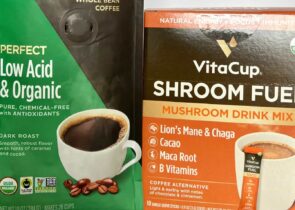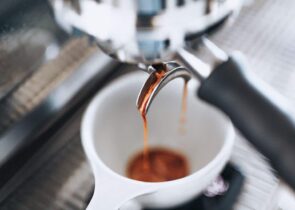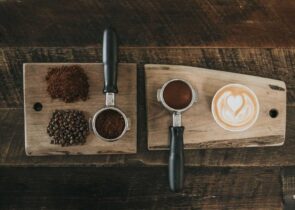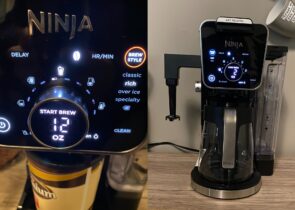Many java lovers swear that when it’s time to take your coffee experience to the next level, Kona coffee beans are the way to go. And we’re willing to bet you’ll understand the hype once you’ve used them to make your morning pot of drip and your afternoon latte.
At A Glance: Our Top 5 Picks For Best Kona Coffees
A word of warning before you rush out to buy a sack of this Hawaiian coffee: it’s one of the most expensive coffees in the world! Scammers are aware of this, so they try to dilute Kona beans with inferior, cheap beans and sell the blend for pure Kona prices. Or worse — they use no Kona beans at all!
We care about you, Roasty reader. So, to save you from falling victim to these scams, we’re sharing a selection of genuine Kona coffee beans for you to try.
But before we dive into gourmet coffee recommendations, let’s look at this excellent coffee more closely, discuss why it’s such a big deal, and share why it commands such a high price.
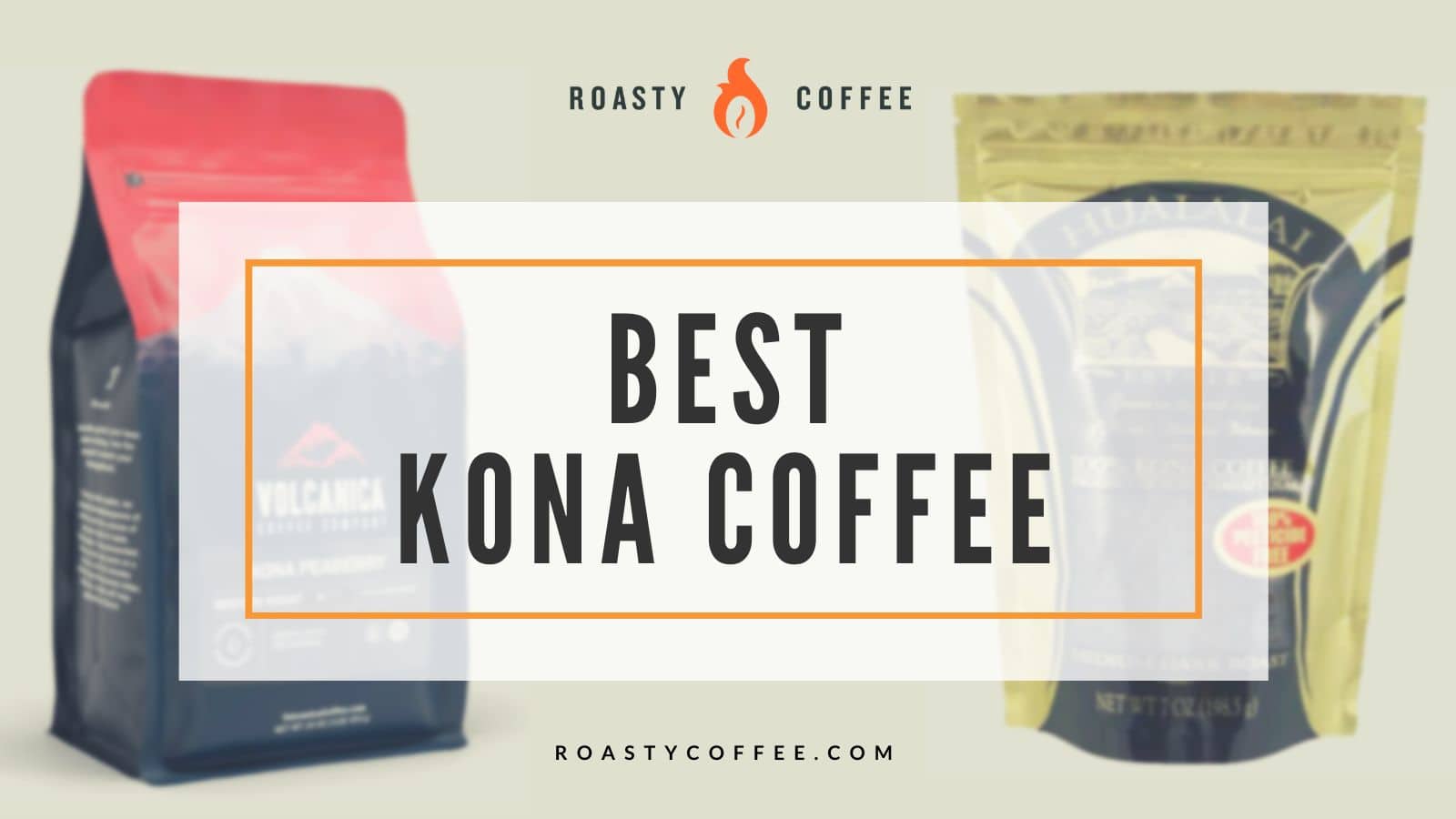
Quick Summary: The Best Kona Coffees
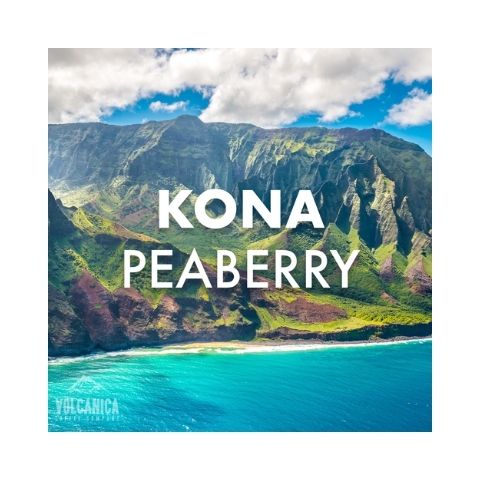 | Our Top Pick Volcanica Kona Peaberry Coffee |
| Check Price → |
 | HUALALAI ESTATE KONA COFFEE |
| Check on Amazon → |
 | Kona Gold Trading Co. Medium Dark Roast |
| Check on Amazon → |
 | Imagine Kona Coffee Beans |
| Check on Amazon → |
 | MOUNTAIN THUNDER PRIVATE RESERVE KONA COFFEE |
| Check on Amazon → |
 | Mulvadi 100% Kona Coffee |
| Check on Amazon → |
 | ROYAL KONA ESTATE KONA COFFEE |
| Check on Amazon → |
 | Blue Horse Coffee Dark Roast Kona Coffee |
| Check on Amazon → |
What Is Kona Coffee?
Arabica beans cultivated in Hawaiian soil on the slopes of Mauna Loa and Hualalai in the southern and northern districts of the Big Island make up Kona coffee.
In the same way that only sparkling white wine from France’s Champagne region can be labeled champagne, only coffee beans from the Kona district can bear the Kona coffee label.
All About Kona Coffee Production
Don Francisco de Paula y Marin first brought coffee beans to Honolulu in 1813, but they wouldn’t make their way to Kona until 1828 or 1829. The region’s mineral-rich and fertile volcanic soil helped coffee plants thrive, making it the coffee farmer’s paradise it remains today.
The area has perfect conditions for growing coffee — sunny mornings, afternoons that bring rain and clouds, and a mild climate that usually isn’t very windy. Plus, each Kona coffee plantation produces a distinct type of bean depending on its individual microclimate. How cool is that?
Kona coffee beans’ growing season extends through the entire year. The coffee plants bloom in February and March (some call the sight of all those blossoms “Kona snow”), and natural pollination occurs. Coffee fruits develop from April through August, while September through January is the harvest season.
Mother Nature takes her sweet time making Kona coffee beans — it takes three years for one of these trees to bear fruit! And even then, you only end up with around 25 pounds of coffee cherries. That sounds like a lot, but it isn’t.
Producing roughly a pound of coffee requires eight pounds of coffee cherries. So, a single Kona tree only yields about three pounds of usable java per season.
Producers pick every coffee cherry by hand, a massively labor-intensive process. Using a harvesting machine would be easier, but since not every cherry ripens simultaneously, hand-picking is the only way to guarantee that only the ripe ones get plucked from the trees.
Then, a machine strips the tart cherries’ flesh and pulp, leaving only the coffee beans behind, ready to be cleaned and sun-dried. Post-harvesting processing only takes 24 hours; a quick turnaround is necessary to keep the beans from spoiling.
What Does Kona Coffee Taste Like?
The first thing you’ll notice when making a pot of Kona coffee is the sweet aroma the brew exudes. Then, when you take a sip, you’ll experience the joe’s flavor profile, full of nuttiness and honey-like sweetness and a taste reminiscent of caramel, butter, cocoa, and fruit.
That, what we described above, is a general overview of Kona coffee’s flavor profile, but the farm it grows on determines exactly how your joe tastes and smells. Some Kona coffee trees yield beans with a more berry-like scent, while others produce a product that smells like vanilla.
Coffee from farms at 1,200 feet above sea level is usually mellow, delicate, and subtle. Beans from higher altitude farms — 1,600 feet or above — have floral notes and rich sugars.
Roasty Rankings: Our Top Picks for the Best Kona Coffee
Volcanica Kona Peaberry Coffee

Volcanica Kona Peaberry Coffee
The Kona Peaberry Coffee is known as the champagne of Kona coffee. Rich with a deep volcanic flavor, Kona Coffee can be described as smooth, nutty, and luscious with an intense aroma and low acidity. The Gran Reserve Kona Peaberry Coffee beans are highly prized for their smooth full flavors, deliciously rich, medium-body, complex taste, and heady aroma.
Longtime Roasty readers know Volcanica Coffee is a brand we love. The company has some impressive coffees, and these Kona peaberry beans are no exception.
According to the brand’s website, Kona peaberry is “the champagne of coffee.” That and the fact that the beans come from mineral-filled volcanic soil on the slopes of Mauna Loa — can you say rich soil, sunny mornings, and abundant rainfall? — it isn’t surprising they’re so sought-after.
Peaberry Kona makes up about five percent of the Kona coffee variety, and when the good folks at Volcanica sent us a free sample to try, we jumped at the chance to experience it, and we’ve got to say it was truly exceptional.
We’re not necessarily coffee snobs (OK, maybe the jury’s still out on that one). But we can certainly taste the difference between this smooth-flavored joe and some batch of grocery store beans misleadingly marketed as Kona.
Hualalai Estate Kona Coffee
Hualalai Estate ensures only exceptional coffee beans make it into the bag you purchased. Plus, the company only uses uniform beans, which means you’re more likely to end up with a consistently roasted product and, in turn, a better-tasting cup of coffee.
Hualalai Estate began as a passion project in 1996 and sources coffee beans from multiple farms. It’s a great deal for all parties involved. Farmers can sell their joe without needing to market it, and Hualalai gets to sell only the best Hawaiian coffees.
Kona Gold Trading Co. Medium Dark Roast
We believe all big coffee fans should try Kona coffee, and buying a bag of Kona Gold Trading Co.’s beans is a great way to see what all the hype’s about. The family-owned estate produces award-winning coffee (and yummy rum cakes!), so you can trust this as a high-quality Kona coffee option.
This delicious coffee — it earned an Extra Fancy grade, by the way — grows in volcanic soil under the shade of ohia and macadamia trees. After, the beans are hand-picked, wet-processed, sun-dried, and air-roasted.
That kind of care during production leads to a clean-tasting cup with fruity notes, low acid content, and a solid caffeine kick.
Imagine Kona Coffee Beans
Imagine’s 100 percent Kona coffee beans ended up on this buying guide thanks to their rich flavor when brewed. The multiple first-place Agency for Valorization of Agricultural Products (AVPA) wins, plus the host of other prestigious awards, don’t hurt the case for this java, either.
The medium-dark roast premium coffee’s sweet flavor is robust, and no bitter aftertaste lingers after sipping it. The air-roasted, low-acid beans are perfect with multiple brew methods, from drip coffee makers to French presses to cold brew makers.
Mountain Thunder Private Reserve Kona Coffee
Mountain Thunder’s Private Reserve Vienna roast is the farm’s most popular product. According to the folks at Mountain Thunder, they represent the best things Kona beans have to offer: they brew a batch of extraordinarily smooth coffee and balance aroma, acidity, and flavor perfectly.
Once harvested, these beans get cleaned, graded, and processed through a Satake Optical Color Sorter that removes any black, orange, or yellow beans.
Since those tend to leave an undesirable, bitter taste in your mouth, the effort made to remove them means you end up with only the most delicious flavors — nutty, chocolatey goodness with cinnamon overtones — in your coffee mug.
Mulvadi 100% Kona Coffee
Many think Mulvadi Corporation sells one of the best organic Kona coffees available. It’s the gold standard. Maybe that’s why the beans come packaged in a gold foil bag!
Mulvadi prides itself on offering high-quality Hawaiian coffee (the company sells K’au and Kona peaberry beans, too, plus a Kona blend) and goodies — macadamia nuts, granola, macadamia nut brittle, etc. — at competitive prices.
So, while you’re buying a batch of beans and preparing to brew a pot of this smooth, low-acid coffee, treat yourself to something yummy.
Royal Kona Estate Kona Coffee
Since Royal Kona Coffee burst onto the scene in 1969, the Hawaii Coffee Company-owned brand has delivered mug after mug of Kona-grown goodness. Take just one sip of this smooth, full-bodied joe, and you’ll understand why Royal Kona has been well-loved for years.
Royal Kona’s 100 percent Kona coffee is a product of the world’s largest Kona roaster, and it’s Hawaii’s leading supplier of coffee to the state’s hotels, restaurants, and retailers.
It’s no wonder many businesses want to get their hands on the stuff — each bean is plucked from the best of the Kona coffee bean harvests and roasted to medium perfection!
Blue Horse Coffee Dark Roast Kona Coffee
Blue Horse is a company that takes Kona coffee farming seriously. Its farmers prioritize sustainability and commit to doing right by each other, their customers, their community, and the Big Island of Hawaii. That dedication to doing the job right has paid off, as they’ve built and maintained a loyal customer base since opening in 2005.
These fine premium beans grow in the shade on a small family farm in the Kona coffee belt, and once hand-picked, they’re rain-washed and sun-dried. Then, they make their way to the company’s roasting facility. Once roasting is over, the beans are sealed safely in freshness-ensuring packages.
Get your hands on one and use these dark roast beans with a manual or automatic drip machine, or grind them finely to put into your espresso machine.
Making the Grade: About the Kona Coffee Rating System
The Hawaii Department of Agriculture (HDOA) tests and grades every batch of Kona coffee. So, look for the HDOA grade on the bag of coffee beans you’re purchasing to ensure you get the best of the best.
The HDOA uses various criteria — size, shape, rarity, and moisture content — to grade these beans. They also consider imperfections.
Like most other coffee roasters, Hawaiian roasters prefer beans with the fewest defects, as chips, hollows, and other deformities prevent them from roasting uniformly. A non-uniform roast means none of the complex flavors you’d expect from good coffee.
The HDOA separates Kona coffee into Type 1 and Type 2. Each has its own grades.
Type 1 Kona Coffee Grades
- Extra Fancy: These are the largest-sized Kona coffee beans, unable to pass through the 19/64″ coffee grading screen hole. These are the cream of the Kona crop with the most moisture and fewest imperfections (HDOA allows eight defects per 300 grams of coffee).
- Fancy: Fancy beans are the second largest, unable to pass through the 18/64″ grading screen hole. The HDOA allows 12 imperfections per 300 grams.
- Number 1: Contrary to its name’s implications, Number 1 is the third-best Kona coffee grade. These beans are smaller than their Fancy counterparts, unable to pass through the 16/64″ hole. The margin for imperfections is wider here, with the HDOA allowing 18 imperfections per 300 grams.
- Select: Select beans are the second smallest of the Kona coffee region beans. Batches of these beans are allowed up to five percent of defects, depending on weight.
- Prime: Prime beans don’t necessarily brew gross coffee but are the lowest quality of the Kona variety. These small beans are allowed up to 20 percent worth of defects. If you see a Kona coffee blend, it probably uses these beans.
You should also know that Type 2 beans can earn one of two additional grades, Number 3 and Off-grade. However, these beans cannot be classified as Kona, even if they grew in that part of the Big Island.
Per the HDOA, the Number 3 coffee grade allows a whopping 35 percent of defects. Any lower-quality coffee bean gets the off-grade ranking. Those defective beans are prohibited from being labeled Kona and can’t be called Hawaiian at all.
Type 2 Kona Coffee Grades
- Peaberry Number 1: These little guys, the best of their kind, can’t pass through a 10/64″ hole and have no more than 18 defects per 300 grams.
- Peaberry Prime: Peaberry prime is the lowest grade of Type 2 Kona beans and is allowed up to 25 percent worth of imperfections per batch of beans.
How to Find Authentic Kona Coffee
Even though we’ve rounded up the best genuine Kona coffees we could find for you, we know some curious coffee drinkers might be itching to do their own digging to see what else is out there.
Be careful in your search, though. It’s pretty standard practice for sellers to slap a Kona label on their coffee products even if it’s just, say, 10 percent Kona and 90 percent foreign-origin beans.
This practice is skeevy, but it isn’t illegal, so you might not think it too bad to buy from these sellers. However, you’re more likely to end up with subpar-tasting or imperfect beans.
So, you might as well search for the real stuff, especially if you’re passionate about brewing delicious joe.
So, how do you know you’ve got real, excellent-quality Kona coffee?
- Check the coffee packaging. If there is no mention of Hawaii or Hawaiian coffee farms on the product label, walk away. Read the fine print, too! Hawaiian law states that coffee bags must print the percentage of Kona beans on the label; finding that info keeps you from paying 100-percent Kona prices for a 10-percent Kona blend.
- Find out where the coffee beans came from. Bean origin is the ultimate indicator of Kona coffee. They had to have been grown in the Kona district on Hawaii’s Big Island; if they came from anywhere else, even one of the other Hawaiian islands, it just ain’t Kona.
- Steer clear of the term “Hawaiian flavors.” Instead of mentioning the Kona coffee-growing region, some brands attempt to boost sales by claiming their beans have desirable Hawaiian flavors or tastes. However, that doesn’t mean genuine Kona! Some areas of Hawaii have poor climate conditions for growing coffee; they’re either too wet or too hot to produce good beans.
- Avoid Kona blend coffee. Generally, we recommend avoiding anything labeled as a “Kona blend.” Only 10 percent of these blends have to be genuine Kona, and the other 90 percent are often low-quality foreign beans that ruin the sipping experience. Yes, there are a few exceptions — some Kona blends brew a decent cup — but if you’re after an authentic Kona experience, you’ll need to buy 100 percent pure Kona instead.
Where should you buy Kona coffee?
Most genuine Kona coffee producers have websites, and ordering directly from them is probably your safest bet at getting the real deal.
FAQs About Kona Coffee
You’ve still got questions, and we’ve got answers. Let’s dive in!
Does Starbucks sell Kona coffee?
If you want to experience the clean taste of Hawaii soil-grown Kona coffee without giving up your Starbucks brand loyalty, we’ve got good news and bad news.
The good news is that your favorite coffee company released a 100 percent Kona coffee product in 2012. The bad news is that it was a limited-release coffee, and while there was a second release of the stuff in 2015, it sold out fast.
The company hasn’t released any information about a third launch, but we’re willing to bet it’s possible. If Starbucks does bring back the exclusive joe, getting your hands on a bag might be hard.
What’s the best roast level for Kona coffee?
The ideal roast level for Kona coffee ultimately depends on drinker preferences. However, we think light or medium roasts are best here; darker roast levels might mask the beans’ original flavors.
Is Kona coffee high in caffeine?
Did you know the amount of caffeine in a cup of black coffee is partially determined by the type of coffee bean used to brew it?
Compared to beans from other origins, Kona coffee has a pretty high caffeine percentage. For context, the commonly enjoyed Ethiopian Harrar bean only has a 1.13 percent caffeine content, while Kona Extra Prime has a 1.32 percent caffeine content.
What makes Kona so expensive?
Several factors contribute to Kona coffee’s price point — coffee lovers should expect to spend around $20 per pound on this stuff if it’s non-organic and around $50 for organic beans — and the first is supply and demand.
Since it grows on a relatively small piece of land, the Kona coffee bean yield isn’t large enough to accommodate everyone trying to get their hands on some of it. When demand outweighs supply, the price point increases; it’s the law of supply and demand at work.
Labor costs also contribute to Kona coffee’s price. These beans grow on steep volcanic slopes that bean-picking machines can’t navigate. So, human labor is an indispensable part of the Kona joe production process.
Since Hawaii is part of the United States, these workers get paid according to U.S. labor regulations. Those wages are higher than in other countries, so coffee prices must be high enough to cover them.
What makes Kona coffee so special?
Besides its unique growing conditions, fantastic flavor profile, and distinct aroma, Kona coffee is special because of its low acid content. It’s gentle on the digestive system and smooth on the palate — no heartburn here.
What’s the best brewing method for Kona coffee?
Since beans grown in the Kona region are known for producing unique, flavorful coffee, we recommend pairing them with a manual brewing method. The French press is our tool of choice for brewing Kona.
Since no paper filters are involved, all of the beans’ flavor-filled oils make it into your cup; you’ll experience the Kona brew’s fruity notes to their fullest extent.
Wrapping It Up
If you’re a true coffee addict (you know…like all of us here at Roasty), you need to try Kona coffee at least once before you die. Period. But make sure you’re getting the good stuff; the low-quality beans aren’t going to cut it.
Although genuine Kona is pricier than other coffees, we think the cup of exceptional coffee you’ll brew is worth the expense. Sipping the smooth, aromatic brew will make you feel like you’re on a Hawaiian vacation, so take your time and savor every delicious drop.
Happy Caffeinating!










